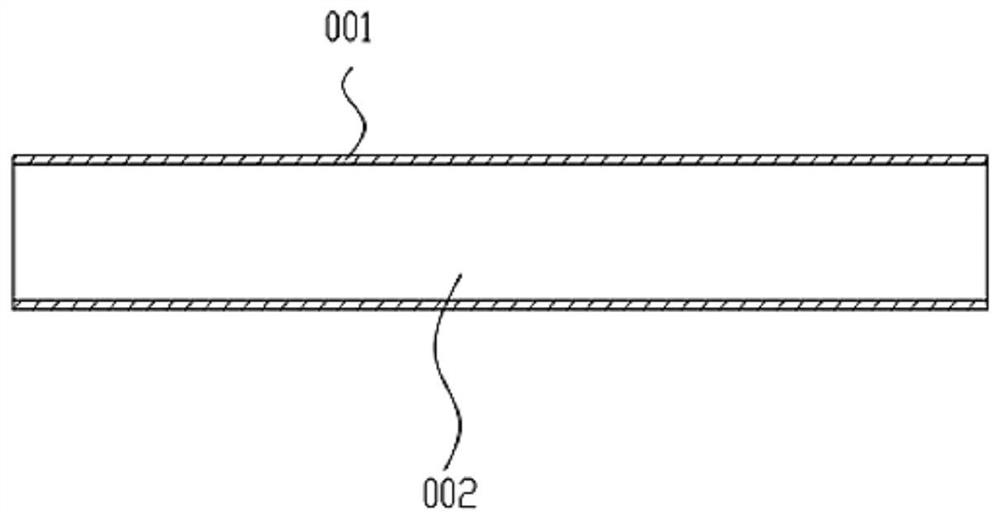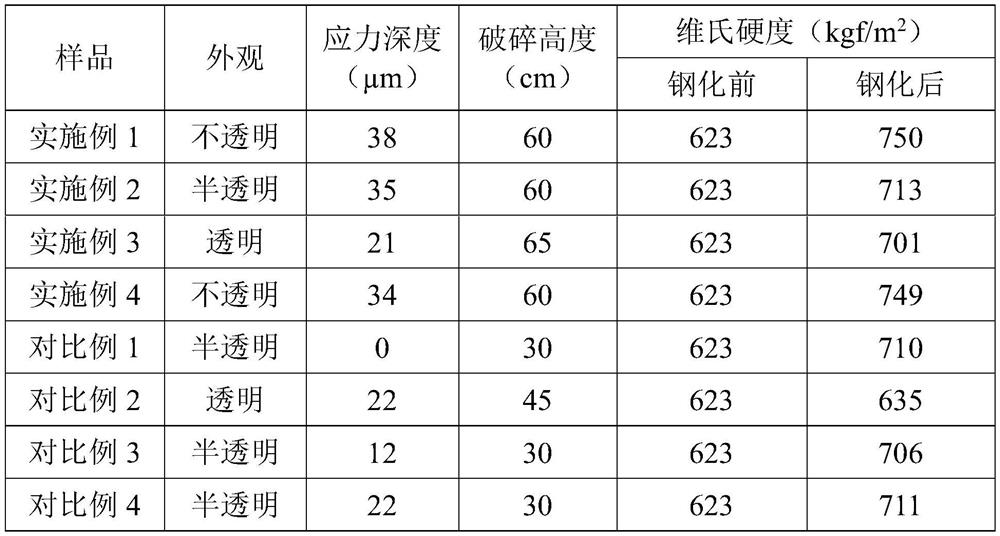Glass-ceramic and its tempering method and application
A kind of glass-ceramic, glass technology, applied in glass tempering, glass manufacturing equipment, electrical equipment shell/cabinet/drawer and other directions, can solve the problem of small degree of ion exchange, temperature drop, not suitable for glass-ceramic and so on
- Summary
- Abstract
- Description
- Claims
- Application Information
AI Technical Summary
Problems solved by technology
Method used
Image
Examples
Embodiment 1
[0097] This embodiment provides a method for tempering glass-ceramic and a glass-ceramic prepared by the tempering method.
[0098] (1) The composition of the glass-ceramic precursor in this embodiment is as follows:
[0099] MgO 6%; ZnO 7%; Al 2 O 3 20%; SiO 2 50%; Na 2 O 4%; CaO 1%; SnO 2 1%; TiO 2 2%; ZrO 4%; P 2 O 5 2%; Sb 2 O 3 1%; B 2 O 3 2%.
[0100] The glass raw materials are: magnesium carbonate, zinc oxide, aluminum oxide, silicon dioxide, sodium carbonate, calcium carbonate, tin oxide, titanium dioxide, zirconium oxide, ammonium dihydrogen phosphate, sodium antimonate and boric acid.
[0101] After converting the ingredients, mix the glass raw materials and additives evenly, and put them into a glass melting furnace for melting at a temperature of 1550°C for 3 hours. After the melting is completed, it is poured into a mold preheated to 500° C. to form a large-volume glass-ceramic precursor.
[0102] (2) The glass-ceramic precursor is cut and pol...
Embodiment 2
[0109] This embodiment provides a method for tempering glass-ceramic and a glass-ceramic prepared by the tempering method.
[0110] (1) The composition of the glass-ceramic precursor in this embodiment is as follows:
[0111] MgO 6%; ZnO 7%; Al 2 O 3 20%; SiO 2 50%; Na 2 O 4%; CaO 1%; SnO 2 1%; TiO 2 2%; ZrO 4%; P 2 O 5 2%; Sb 2 O 3 1%; B 2 O 3 2%.
[0112] The glass raw materials are: magnesium carbonate, zinc oxide, aluminum oxide, silicon dioxide, sodium carbonate, calcium carbonate, tin oxide, titanium dioxide, zirconium oxide, ammonium dihydrogen phosphate, sodium antimonate and boric acid.
[0113] After converting the ingredients, mix the glass raw materials and additives evenly, and put them into a glass melting furnace for melting at a temperature of 1550°C for 3 hours. After the melting is completed, it is poured into a mold preheated to 500° C. to form a large-volume glass-ceramic precursor.
[0114] (2) The glass-ceramic precursor is cut and pol...
Embodiment 3
[0120] This embodiment provides a method for tempering glass-ceramic and a glass-ceramic prepared by the tempering method.
[0121] (1) The composition of the glass-ceramic precursor in this embodiment is as follows:
[0122] MgO 6%; ZnO 7%; Al 2 O 3 20%; SiO 2 50%; Na 2 O 4%; CaO 1%; SnO 2 1%; TiO 2 2%; ZrO 4%; P 2 O 5 2%; Sb 2 O 3 1%; B 2 O 3 2%.
[0123] The glass raw materials are: magnesium carbonate, zinc oxide, aluminum oxide, silicon dioxide, sodium carbonate, calcium carbonate, tin oxide, titanium dioxide, zirconium oxide, ammonium dihydrogen phosphate, sodium antimonate and boric acid.
[0124] After converting the ingredients, mix the glass raw materials and additives evenly, and put them into a glass melting furnace for melting at a temperature of 1550°C for 3 hours. After the melting is completed, it is poured into a mold preheated to 500° C. to form a large-volume glass-ceramic precursor.
[0125] (2) The glass-ceramic precursor is cut and pol...
PUM
| Property | Measurement | Unit |
|---|---|---|
| thickness | aaaaa | aaaaa |
| Vickers hardness | aaaaa | aaaaa |
| depth | aaaaa | aaaaa |
Abstract
Description
Claims
Application Information
 Login to View More
Login to View More - R&D
- Intellectual Property
- Life Sciences
- Materials
- Tech Scout
- Unparalleled Data Quality
- Higher Quality Content
- 60% Fewer Hallucinations
Browse by: Latest US Patents, China's latest patents, Technical Efficacy Thesaurus, Application Domain, Technology Topic, Popular Technical Reports.
© 2025 PatSnap. All rights reserved.Legal|Privacy policy|Modern Slavery Act Transparency Statement|Sitemap|About US| Contact US: help@patsnap.com


